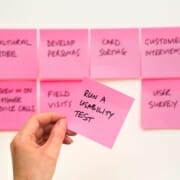Mobile App Design Do’s and Don’ts
Mobile app design may seem easy, but it’s not. An inexperienced or overconfident developer may think they can cobble together the mobile UI at the last minute. But that results in a clunky and unintuitive mobile app that only offers a frustrating and poor user experience. That’s why many of the best app developers have at least one UI/UX designer on the team that focuses exclusively on design.
But what if you’re an appreneur or startup that’s new to mobile app development? Perhaps, you haven’t had the time or funding to hire an experienced UI/UX designer. Or you possess some design skills of your own but don’t quite know how to apply these to your mobile apps. Please don’t fret, as we’re about to reveal several handy tips to help you out!
Mobile App Design Must Do’s
Your app’s success largely depends on how well you go about creating a fantastic user experience. Therefore, it’s crucial to be detail-oriented and have a checklist of the following must-do tasks.
1. Study The App Market And Latest Mobile UI Trends
The app market is very dynamic and changes constantly. And what was popular two years ago may no longer appeal to today’s audience. That’s why you should study the top trending apps in the marketplace carefully and consistently.
Start by using the storefronts themselves, and see what apps appear in the top spots. Google Play makes things even easier for you, as it shows an estimation of downloads of every app.
Then, download and try out several of the most successful apps to see what makes them tick. More importantly, pay close attention to their mobile UI to determine whether they offer a satisfactory user experience. And study all their UI elements, such as the app bar, checkboxes, buttons, menus, and other interactive touch targets.
Spend time spotting notable design trends in all of these. See if they’re using rounded or square corners on checkboxes and menus. Moreover, see if they use flat shading, glass effects, gradients, shadows, or 3D UI elements. And take inspiration from any impressive mobile UI animations, motion design, and other visual effects.
2. Keep Your Mobile UI Clean And Functional
Given that the mobile app market is incredibly competitive, you may want to outdo your rivals. Perhaps, you’re developing a music-making app and plan to offer more features than BandLab or FL Studio Mobile. But the reason these apps are so successful is due to their ease-of-use and clean, uncluttered mobile UI.
And if we take a deeper look at FL Studio Mobile, we’ll find that it’s a significantly stripped-down iteration of the desktop version. The desktop version is a professional suite used by producers behind many hit songs. It’s also a fairly complex tool with a bit of a learning curve, especially for newcomers to digital music production. Furthermore, its UI may seem overwhelming to many and have them searching through the manual.
The developers behind FL Studio knew that this comprehensive production suite would never work on mobile. So they created a simple, inviting, and colorful UI without the bells and whistles found in the desktop version.
Therefore, instead of offering users everything but the kitchen sink, give them only the bare essentials. A clean, minimalist mobile UI that allows users to quickly and intuitively create professional-sounding songs will win the day. You can always add more features later, specifically when users ask for these.
3. Reward User Input With The Appropriate Feedback
Your mobile app design should focus squarely on what users want. And nowadays, users prefer snappy and responsive apps that look visually stunning. They also need apps to immediately register their actions and provide visual cues that this has happened successfully. That’s why it’s crucial to have a well-implemented input and feedback mechanism with every app you ship.
So how do you about creating such a mechanism? Firstly, you should make your app as tap-friendly as possible. Ensure that all buttons and other touch targets on the screen are easily identifiable. The last thing you want is users repeatedly tapping on a checkbox or menu that doesn’t register their taps because it’s too small, not positioned correctly, or incorrectly conveys its intended use.
And secondly, implement mobile UI animations and transition effects to show that the app has registered the tap. A button may display a blink effect soon after a finger tap, or a menu item may quickly slide sideways and fade after a swipe. And if you work with a UI/UX designer or an experienced app developer such as NS804, they’ll come up with many more imaginative ways to enhance your input and feedback mechanism.
Mobile App Design Don’ts
Creating amazing apps that will keep users engaged is very difficult but rewarding work. Yet even the most experienced developers can ship substandard apps if they make the following mistakes.
1. Implementing Poor User Flow
There’s nothing worse than users trying out an app and then quickly giving up in frustration and subsequently uninstalling it from their phones.
So why is this such a common occurrence, and why are so many appreneurs and developers getting it wrong? A primary reason why this happens is due to poor user flow. Either most developers didn’t correctly map out the sequence of events that users will take after running the app for the first time, or they didn’t consider user flow at all.
Whether you’re developing an m-commerce store, mobile game, or social media app, you’ll need to create a frictionless user experience. Start by mapping out the user flow from the welcome screen through to every page users will access. You may use flow charts to create an intuitive user flow that won’t drive users to a dead page or take actions that will frustrate them.
2. Interrupting And Annoying Users
Don’t ever take your users for granted just because they seem to be enjoying your app. It’s all too easy to lose users the minute you interrupt them when there’s no reason to do so. The last thing that users want is to respond to a feedback survey when they’ve only been using your app for a short period or while trying to complete a task.
Keep in mind that most users are still evaluating your app during those initial hours of usage. Thus, you want to make a good impression by ditching annoying popups and surveys during this critical stage. Instead, give your users enough time to make a proper assessment of your app before asking for feedback, ratings, and reviews.
3. Using Complex Words And Terms Unnecessarily
Most mobile app users are not computer scientists or programmers, so avoid using complex words and terms they don’t understand. For example, your latest app may have impressive artificial learning (AI) algorithms that track down hard-to-find ebooks. You may want users to know about these algorithms by adding their names somewhere within the app or mobile UI, but that’s unnecessary.
It’s better to allow these algorithms to do their work behind the scenes. Users will realize that you’ve created a great app by how well it tracks those ebooks. After all, they don’t care about the inner workings of your app or want to memorize technical terminology. If anything, you’ll likely lower user engagement or even lose users if your wording is too technical or if you rely on marketing catchphrases.
The Bottom Line
Most of the best apps closely follow solid mobile app design fundamentals. Much work goes into creating a mobile UI that not only looks great but is clean and intuitive. But it’s also crucial to follow the latest design trends that will make even the most renowned UI/UX designer look on in envy. Contact NS804 to learn how we’ll help you develop phenomenal apps that look and feel great!













Leave a Reply
Want to join the discussion?Feel free to contribute!